| Botanical Name |
|
| Family |
Geraniaceae - The geranium family. |
| Pronunciation |
pe-lar-GO-nee-um pan-dur-ih-FOR-mee |
| Common Name(s) |
English: Balsam-scented geranium; Fiddle leaf geranium
|
| Plant Group |
- Shrub A woody plant of relatively low height, having several stems arising from the base and lacking a single trunk; a bush.
|
| Plant Size |
- Medium
| Tree | 10m to 16m |
| Shrub | 1m to 2m |
| Perennial/ground cover | 40cm to 60cm |
| Bulb | 40cm to 60cm |
| Succulent | 40cm to 60cm |
|
| Position |
- Partial Shade The area is in shade for part of the day and in full sun for part of the day.
- Sun The area is in full sun for all or most of the day, all year round.
|
| General Information |
- Drought Tolerance: High The plant is well adapted to arid conditions; it can survive long periods of drought and high temperatures without extra water.
- Evergreen Plants that have leaves all year round.
- Fragrant / Aromatic These plants posses a strong, usually pleasant odour.
- Frost: Hardy The plant can withstand freezing temperatures or frost without artificial protection.
- Prune hard after flowering Fast growing shrubs that grow lanky within a season. Cut off branches and stems of these plants to a third of their original length. This will increase the yield of flowers, improve the plants shape and enhance the structural strength of main branches.
- Roots Non-invasive Safe to plant near pools, paving, walls or buildings.
- Sand tolerant Plants adapted to survive in nutrient poor, very sandy soils.
- Water Wise Plant species originating from low rainfall regions that require less water to survive and thrive than other plant species.
|
| Specific Information |
Pelargonium panduriforme is a sprawling to erect shrub with tall stems. The plant can reach up to a height of 1.75 m. The stems are soft and green when young but become woody as the shrub matures. The large, soft, fiddle-shaped, hairy leaves are fairly sticky and strongly balm-scented. It is reasonably fast-growing, showy and long-flowering.
I seldom let my plants grow to over a meter as the branches get long and top heavy, causing them to sprawl untidily. I have found this species to be insect and disease resistant.
|
| Ad Break |
|
| Flowers |
| Description |
Pelargonium flower with long petals, the three lower petals being plain in colour and the two upper petals streaked with dark pink to magenta, with groups of two to twenty flowers on a thin stalk.
|
| Season |
- Winter to Summer Plants will seldom bloom for the entire season as given in the list, but should flower during a period within these parameters.
|
| Colour |
|
| Growth Rate |
- Fast Specifying growth rate can be very misleading as there is considerable variation of growth rate depending on type and species of plant, available water, supplementary feeding, mulching and general care, as well as the plants suitability and adaptability to the garden environment.
|
| Plant Uses |
- Attracts bees, butterflies or other insects This plant attracts insects which can be food for birds or other creatures in your garden.
- Border A strip of ground, at the edge of a driveway or path in which ornamental plants or shrubs are planted.
- Boundary A plant useful for planting around the edges of the property to form a green or colourful backdrop, an impenetrable hedge, to hide walls or create privacy.
- Container Trees, shrubs and ornamental species that can adapt to growing in a restricted environment.
- Filler Either a fast growing tree or shrub used temporarily to fill in an area while the permanent plants grow to a desired size, or a plant used to fill gaps in borders or beds.
- Pioneer for new gardens A very fast growing plant, able to withstand hardship, that can be used to populate land that has recently been cleared of natural vegetation. These plants pave the way for slower-growing species by adding nutrients to the soil and creating leaf litter.
- Screen A tall hedge of suitable plants planted closely together and used as a windbreak, to block a bad view, to separate parts of the garden or as a backdrop.
- Suitable for coastal gardens Plants adapted to dry, sandy soil, forceful wind, limited rainfall and intense sunlight.
- Wild Garden An indigenous garden planted for the benefit of wildlife and birds. Provides food, water, a variety of mini-biomes and no poisonous chemicals are used.
|
| Distribution and Habitat |
in the south western part of the Eastern Cape from Willowmore to Riebeeck East, on the lower foothills of mountains or in ravines, normally close to streams, with extremely high summer temperatures, moderately low annual rainfall and frost during the winter months
|
| Planting Suggestions |
Pelargonium panduriforme grows easily in a the garden with fairly dry to slightly damp soil. Add compost or fertiliser sparingly to prevent rampant growth. A good layer of mulch and leaf litter will usually keep the soil sufficiently moist. In arid climates with very hot afternoon sun, plant it in an area where it is protected to avoid burnt edges on the leaves. Prune hard after blooming and tip frequently to encourage dense growth and control its sloppy growth habit.
|
| Medicinal Uses |
|
| Ad Break |
|


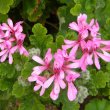
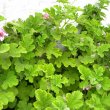
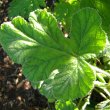

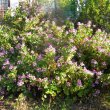
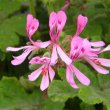


Discuss this plant
Share knowledge, ask a question or give an experience.